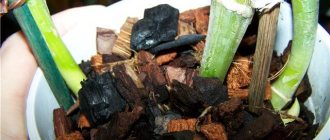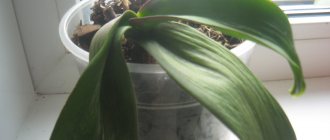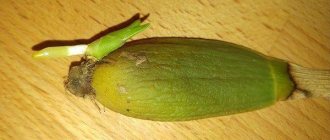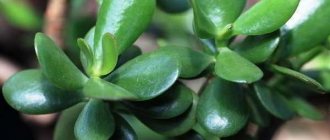Orchid: description of the flower
The Orchid family is divided into 5 subfamilies; among indoor species you can find natural epiphytes, as well as varieties growing in soil. Epiphytes attach to other plants, but are not parasites, that is, they do not receive any nutrients from the main plant. Soil varieties are planted on soils with special characteristics. When growing at home, the characteristics of flower crops are taken into account and they are placed in accordance with the basic requirements. Short description:
- Stem. A single shortened stem grows upward, releasing aerial roots from the leaf axils. May be shaped like a creeping stem in some varieties.
- Leaves. Evergreen type, can grow from 5 to 20 cm, arranged alternately.
- Flowers. Large, axillary. According to the type of inflorescences, they can be spike-shaped or form brushes.
- Roots. Airy, covered with spongy tissue, flat. Some varieties are prone to growing pseudobulbs, that is, false bulbs. The moisture reserve in the bulbs makes orchids look like succulents.
Among the common indoor varieties, the popular varieties are phalaenopsis, dendrobium, and cymbidium. For indoor growing, choose varieties with not strong but pleasant aromas and delicate shades of petals.
indoor orchids in pots
Viral diseases
More often than other genera of orchids, a viral disease can affect cymbidiums, cattleyas, phalaenopsis and vandas.
The last thing you should be afraid of is viral diseases, since they rarely affect orchids. Most often they appear as mosaic spots on leaves and flowers. Also, with viral diseases, characteristic spots in the form of circles, stripes or arrows can be seen on domestic “tropicanas”.
Unfortunately, it is not possible to cure an orchid affected by a viral disease. If you suspect that something is wrong with an epiphytic pet, it should be urgently isolated from other plants. If the assumption is confirmed, then the diseased orchid will have to be disposed of.
Forewarned is forearmed. Now you know everything about orchid diseases and, if something happens, you can protect your plants from their silent enemies.
How to grow an orchid at home
When growing flowers, gardeners face various difficulties that are associated with the characteristics of the crop. The orchid's leaves wither or buds fall off. If the rules of care are violated, the leaves often turn yellow and wither, and may fall off or curl. Home orchids are grown in different ways, choosing the option that suits a particular variety and takes into account the characteristics of the crop. Ordinary soil is not suitable for them; soil is purchased from specialized flower shops.
Placement, growing container
As a planting container, choose a transparent pot, which is equipped with a drainage system. Drainage holes should be located along the bottom and sides. The transparency of the pot allows you to monitor the condition of the substrate and the growth of the root system. An alternative planting option is to place it on the bark of a suitable tree. This method is close to natural conditions, but is only suitable for experienced gardeners. The soil for pot plantings consists of bark, sphagnum, sand, and charcoal.
Lighting
For flowers, choose southern or western windows during the warm season. In winter or autumn, the location is changed. If there is a lack of light, install additional lamps.
Irrigation
An important condition for caring for indoor flowers. Watering is carried out after assessing the external condition. If the orchid has limp leaves, the pot has become light, and there are no drops of condensation on its walls, then watering is necessary. It is carried out using the pallet method. This means that a pot with drainage holes is placed on a tray filled with warm, settled water and left until the roots are completely saturated.
Fertilizing
For fertilization, solutions with nutrients are used. Most often, root watering is done with the selected concentration. One of the feeding options is to place soluble tablets at the bottom of the pot.
Substrate
Regular soil is not suitable for these flowers. They use tree bark of different fractions, drainage and sphagnum moss. The bark allows moisture to pass through well and remains moist for a long time, which is close to natural growth conditions and the natural habitat.
Warning! Excessive waterlogging leads to rotting of the roots. Plants are watered only when the substrate becomes completely dry.
Preventive measures
Why do orchid buds fall off: the main reasons for dropping them
Preventive measures against plant wilting are aimed at organizing proper flower care. This is the only way the foliage will not wrinkle. Initially, properly caring for a plant is much easier than treating it later.
What to do to prevent your orchid from developing limp leaves:
- the humidity in the room where the pot is located should be between 70-80%;
- For planting you need to choose the right substrate. It is best to buy ready-made soil mixture for orchids;
- sunlight should be diffused; it is not recommended to place pots in direct sunlight;
- the temperature should be maintained within 17-25 °C;
- moderate watering. The first sign that watering is not suitable for the orchid is that the roots turn white;
- regular inspection of the bush. You need to carefully examine the underside of the leaf and sinus.
Spraying as part of care
If you follow all these recommendations, the foliage will not wrinkle.
The orchid is a capricious houseplant that cannot simply be planted and forgotten and then hoped that the flower will bloom profusely. You will have to regularly devote time to the plant, this is the only way to grow healthy and abundantly blooming orchids.
Coffee capsule Nescafe Dolce Gusto Chocochino, 3 packs of 16 capsules
1305 ₽ More details
Hot chocolate capsules Nescafe Dolce Gusto Chococino, 8 servings
334 ₽ More details
Table lamps Italy
Reasons leading to wilting of orchid leaves
Epiphytes and lithophytes are kept under close control due to the transparent pot. You can observe how the root system develops and control the process at any stage. In addition to the difficulties associated with unusual conditions of detention, various factors arise that lead to withering.
orchid leaves wither
Why do the leaves wither?
The lower leaves wilt first. The fact is that due to the impossibility of providing power to the above-ground part with the tops and buds, the redistribution of elements begins to occur at the level of the lower plates. If there is a lack of moisture or necessary substances, they begin to turn yellow, dry out, and wither. The cause of wilting may be a consequence of violation of the rules of care and the appearance of parasites:
- Overheating of the plant. Occurs on southern windows with excessive sunlight, they provoke the formation of condensation on the walls of the planting container and activate evaporation. This leads to a change in the structure of the plates.
- Frostbite. This is the main variant of wilting, which is possible due to the pot being exposed to a draft wind when temperatures drop. The limp and soft leaf hangs over the edges of the container and may turn brownish or black.
- Disadvantages of watering. You can determine the lack of water by the appearance of the plant. Orchid leaves wither, turn yellow, and dry out. Dry areas may appear throughout the surface. The reason for wilting can be overflow, then the plates become covered with brown-black spots and single dots.
- Air humidity. High humidity also causes dark spots to appear. This becomes especially noticeable after the next watering. Humidity can be increased where there is no ventilation and condensation accumulates.
- Insect pests. Infestation of parasites often leads to wilting, dryness or yellowing. Insects are detected by careful inspection of parts of the plant. The danger is posed not only by adults, but also by laid clutches of eggs.
Fungal diseases
Diseases of orchids can be provoked by severe waterlogging, violation of temperature and ventilation conditions. In this case, favorable conditions are created for the intensive development of fungi. They are a source of disease. Fungal diseases cause root rot.
No less dangerous are fungal tracheomycosis. Orchid diseases caused by this pathogen affect the vascular system of the plant. At the same time, the lower leaves of the orchid gradually turn yellow and the lower parts of the stem, neck and roots rot. Growth as a whole stops. The disease is practically incurable and leads to the death of the plant. All kinds of spots cause diseases of orchid leaves. These include: powdery mildew, rust, anthracnose, septoria, stangosporosis, phyllosticosis, cercospora. These diseases also affect flowers.
Fungicides are used to treat fungal diseases. It is advisable to use biological products that are less toxic than chemicals.
Why do buds fall off when flowering?
The culture has an extended flowering period. The optimal period is considered to bloom from October to March. Due to the complete discrepancy between room conditions and the usual habitat, flowering is shifted to different periods. When setting buds, the plant concentrates all its energy on future flowering. Complete or partial falling off of tied buds indicates problems. Flower growers begin to look for the reasons why leaves and flowers wither, and buds fall off.
| Possible timing of bud release | Cause |
| in autumn | Lack of lighting. When the peduncle is driven out, the plant does not have enough light for its further development and falls off. For the same reason, the leaves of a blooming orchid wither. |
| Any time of year | Temperature fluctuations, which became a shock for the crop, led to the falling of flowers. |
| in winter | Dry air, increased temperature due to working batteries. First, the leaves begin to wither, then the formed flowers fall off. |
| In summer | Lack of moisture. The roots dry out, this leads to consistent drying out of the above-ground part. |
| Any time of year | Lack of nutrients. |
The shedding of buds is irreversible. When flowers fall off, it is recommended to help remove the half-opened buds and begin treatment.
Advice! If there is a lack of nutrition during flowering, potassium-phosphorus fertilizers are applied. Nitrogen-containing mixtures are excluded, as they contribute to the growth of green mass.
Why do leaves wither and turn yellow after transplanting?
Epiphytes and lithophytes are transplanted to a new location after the first flowering or as the pot becomes too small for the overgrown roots. The transplant is carried out according to the established scheme. Orchids are quite capricious, so in order to avoid mistakes, it is recommended to watch special videos and study the information.
For transplantation, select a suitable container and prepare the substrate. The roots are inspected and, if necessary, dry or damaged parts are removed with sharp garden shears. The sections are treated with crushed activated carbon to avoid fungal infection.
The leaves of the transplanted orchid began to wither
The transplant is secured with tray watering, a root biostimulator is added to the water, this will help the plant quickly adapt to new growth conditions. If, after transplantation, the leaf begins to dry out, turn yellow, and take on an unusually limp appearance, then this indicates a problem, a possible violation of the planting rules:
- Aging. This natural cause may become relevant after transplantation. Changing the pot becomes a new stage in the development of the culture, so the reset process is activated. Wilting and yellowing of the lower plates is a sign that the flower is renewing itself. In this case, each fallen leaf is removed, no other actions are taken.
- Overflow. After transplantation, a flower reacts to waterlogging by rapid yellowing of the lower part along with the stem. If this reason is discovered, it is advised to normalize the irrigation system and wait until the substrate dries completely.
- Water quality. Plants are sensitive to hard water. Rust and chlorine that get to the root system after replanting can harm the plant. To avoid damage to the roots, hard water is softened by adding citric acid.
- Incorrectly selected container and substrate. Repotting may fail if you choose a pot that is too small or too large. Lack of space compresses the roots and leads to yellowing; too much space provokes the accumulation of moisture, which is also harmful to the plant.
- Moving, incorrect placement. The reason for yellowing and wilting after transplantation may be the wrong choice of location. Exotic flowers do not feel comfortable in the kitchen, where they are often adjacent to fruits and vegetables. Some fruits actively emit ethylene, which leads to the activation of processes inside the flower, which negatively affects its natural development.
Advice! After transplanting, during flowering, it is recommended to water the soil with warm, settled rain or melt water.
Basic care mistakes
Experienced flower growers advise not to make common mistakes when purchasing and caring for them. This floral look is often purchased for its spectacular appearance, but after being placed on the windowsill, people often don’t know what to do with the plant. The orchid loves attention and careful, non-aggressive care.
Purchase
The first difficulty a gardener may encounter is purchasing a damaged flower. The blooming appearance can be deceiving. Temperature fluctuations lead to the spread of fungus on the roots, so when purchasing, you should pay attention not to the above-ground part, but to inspecting the root system.
The roots should be smooth, the same color, without plaque or dry spots. They should fit snugly into the pot. The formed buds should not fall off when slightly shaken due to their tight attachment to the stem.
Watering
Orchids are often watered from watering cans or through wide trays. This leads to waterlogging of the roots. Irrigation trays should not be too deep and wide, then there will be no excess moisture. There is another method - immersing the pot in a bucket of water.
Experienced flower growers and collectors of exotic flowers water plants using the wick method. When transplanting, a wick is placed at the bottom of the pot, which is constantly moistened. In this way, the stem is constantly fed with a small amount of moisture, which does not lead to an excess.
Accumulation of substrate at the root collar
This is a common problem that causes flower loss. When purchasing, the owner does not have the opportunity to examine the substrate on every part of the container. Moisture-intensive soil accumulates near the root collar and leaves it wet for a long time. Such a moisture-intensive substrate can be a lump from previous transplants, which consists of several layers.
Increasing humidity by spraying
This mistake is associated with the idea of the orchid as a moisture-loving crop. The owners begin to actively spray the plant along its entire length. Sometimes the buds are sprayed. There is no need to do this. An error can lead to rotting and loss of the phalaenopsis. Humidity is important for epiphytes, but this is achieved by installing humidifiers near the pot or spraying the air near it.
errors in care led to wilting of orchid leaves
The appearance of pests
The danger comes from pests that appear as a result of imperfect temperature conditions. Humidity or dry air leads to active reproduction of parasites. Orchids are susceptible to attacks from various insects:
- mealybug;
- aphid;
- whitefly;
- spider mite;
- thrips.
The fight against any species involves carrying out step-by-step treatment measures. First, the culture is rid of adult individuals, then the remains of deposited larvae are eliminated, and treatment begins.
How to distinguish when it was sick and when pests appeared?
To determine the problem, you need to carefully examine the plant. The orchid may be susceptible to disease, virus, or insect attack. Only a visual inspection will give the correct answer as to what problem you are facing.
Signs of disease:
- If dark dots, dark or brown spots (with or without rims) appear on the leaves, then this is rot.
- If the base of the leaf has turned yellow, shriveled, or the surface has wrinkled, this plant is sick from improper care. It can be cured by restoring the light regime and necessary watering.
- If root rot occurs, this is again a sign of poor care, most likely overwatering.
- If the leaves become limp, white spots appear on them - problems with the root system.
- If the orchids develop light and then brown streaks, which then merge into stripes, and the leaves turn yellow and fall off, this is a viral disease.
Signs of pests:
- If young shoots, flowers, buds change color, fall off, and silvery spots appear on the leaves, they are uneven - most likely these are insects.
- If there are white lumps in the leaf axils, these are pests.
- If the leaves have holes or uneven edges, the orchids most likely have snails.
- If the shoots or leaves are covered with brown growths and warts that are easy to remove, then these are also pests (scale insects and false scale insects).
- If the leaves become sticky, this is also a sign of the presence of harmful insects.
- If barely noticeable red dots move around the plant or the leaves and shoots have acquired a whitish tint, we are also talking about insects.
What to do if flowers and leaves wither
When purchasing, you want to get a flower that will bloom steadily and delight you with its healthy appearance. If basic care errors cannot be avoided, then they use methods that help eliminate the consequences and cure the plant. The resuscitation process may take a long time, depending on the stage at which treatment was started. In the initial stages of wilting and yellowing, several actions are sufficient:
- change of location;
- additional lighting;
- cessation of watering or additional watering;
- control over air humidity levels, temperature reduction, ventilation.
These actions help to understand why the leaves of an orchid wither and to choose optimal conditions. If none of the options helps, then proceed with the necessary transplantation. When replanting, an additional reason for yellowing and wilting may become clear. This may be rotting of the root collar due to a wet lump of substrate or the presence of pests on the roots. The plant begins to be saved in the early stages of decay. Damaged roots are cut off, processing the cuts, changing the planting container and substrate.










